
This weekend on YOUR HEALTH® Adam and guest co-host Dr. Stephen Hooper welcome Renée Hodges — author of Saving Bobby: Heroes and Heroin in One Small Community — for a conversation about her nephew’s journey back from opioid addiction.
You can catch the episode on:
WCHL 97.9 FM
- Saturday, July 21 at 9 a.m.
- Sunday, July 22 at 9 a.m. and 5 p.m.
- Monday, July 23 at 6 p.m.
KKAG Retro Radio 88.3 FM
- Sunday, July 22 at 7 a.m.
Listen to the show!
Download the episode from the Carolina Digital Repository
GET HELP!
Substance Abuse and Mental Health (SAMHSA) National Helpline National Helpline – 1-800-662-HELP (4357)
SAMHSA’s National Helpline is a free, confidential, 24/7, 365-day-a-year treatment referral and information service (in English and Spanish) for individuals and families facing mental and/or substance use disorders.
DRUG ABUSE
- What to Do if You Have a Problem with Drugs
- Have a Drug Problem? Help for Teens
- Partnership for Drug-Free Kids: Where Families Find Answers
- Drugs and Young People
ALCOHOL ABUSE
- Am I an Alcoholic Self Test
- Talk to Your Child About Alcohol
- Answering Questions about Underage Drinking
FOR FAMILIES AND LOVED ONES
GENERAL INFORMATION ABOUT SUBSTANCE ABUSE AND ADDICTION
- Drug Addiction (Substance Use Disorder)
- Opioid Addiction
- Alcoholism and Alcohol Abuse
- Biology of Addiction: Drugs and Alcohol Can Hijack Your Brain
- Genes and Addiction
OTHER ADDICTIONS
